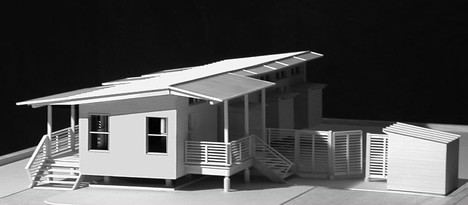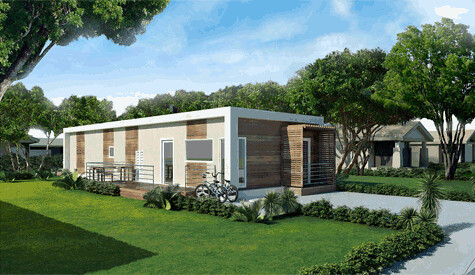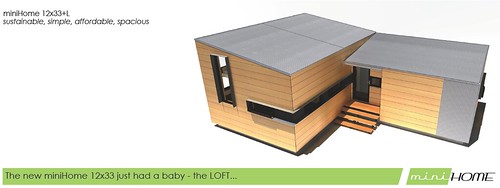 Despite an economy in a deepening recession, plummeting housing values, tight credit and rising foreclosure rates and unemployment, the United States may be on the cusp of a new housing mini-boom – or rather, a ‘mini-housing’ boom. Of course we first need to stabilize the economy and create millions of new jobs rebuilding our nation’s energy and public transportation infrastructure, but that’s an issue for another discussion.
Despite an economy in a deepening recession, plummeting housing values, tight credit and rising foreclosure rates and unemployment, the United States may be on the cusp of a new housing mini-boom – or rather, a ‘mini-housing’ boom. Of course we first need to stabilize the economy and create millions of new jobs rebuilding our nation’s energy and public transportation infrastructure, but that’s an issue for another discussion.
State of US Housing Stock
Consumers, when they are once again able to afford a new home, are likely to embrace a new generation of homes that are smaller, sustainable, modular and less costly to own and maintain. Researchers at MIT’s Department of Architecture House_n project foresee the next generation of homes as “a center for proactive health care, distributed energy production, commerce and learning.” Sadly, the existing base of homes is ill-suited to meet these needs, and are so poorly insulated that an estimated $16B of energy is lost each year through holes and cracks. House_n researchers add that:
“The housing industry, for the most part, is decentralized, resistant to change, wary of new technology, labor intensive inefficient and unresponsive to the needs of individuals. Most people live in places that are low-grade, low-tech, inflexible, disruptive to upgrade, high-maintenance and ill-designed.” (ouch!)
Green Homes Today
Currently, less than 1% of the 126M total housing units in the US are ‘green’. Since 2001, homebuilders have built an average of 1.5M homes per year, and approximately 2% of new homes were built green in 2005 (that’s only 30K homes). This number is expected to rise to 10% by 2010, according to a Calvert Group report titled “Greener Pastures for America’s Homebuilders?”. Demand for sustainable housing has been so strong that even during the current housing slump the green building industry has been growing 30% per year.
Tomorrow’s Green Homes
So what does a house built during a ‘mini-home’ boom look like? If you made it to the USGBC’s Greenbuild365 conference Nov. 19-21, or like me caught some of the fantastic sessions via webcast, you heard a very clear call to builders for a “1,400 square feet home with a garage”. This is quite a reversal of a decades-long trend that saw the average home size increase to 2,300 square feet in 2004, from just over 1,000 square feet in 1950, and a return to the average home size in 1970. Note that the larger home trend has been combined with a corresponding decrease in family size of 3.1 to 2.6 persons per home, making today’s homes even less efficient.
Greener Pastures Ahead
San Francisco’s Project FROG was highlighted in Ian’s recent CleanTechies post, and is one of several promising companies with innovative and truly inspiring approaches to sustainable building design. Project FROG’s (Flexible Response to Ongoing Growth) award-winning designs include ‘net-zero energy’ classrooms that are 1,280 square feet in size, require 75% less energy than traditional classrooms, and feature abundant natural light and superior air quality.
miniHome, a Canadian company focused on sustainable residential housing, takes a similar but slightly different approach with its 5 different models. The miniHome is technically classified as a ‘travel trailer’, meaning it is built on a permanent steel frame with 3 axles, and can be towed on major roads in North America without a special license or police escort. The miniHome’s compact size allows it to clear highway overpasses and its thoughtful floor plans make the home feel larger than it is. The miniHome claims to use 1/10 the water and fuel, and 1/100 the electricity of a typical 2,000 square foot home – which allows a few solar panels to easily serve the amazingly frugal electric load of 1.5 kWh per day. The 2009 miniHome is 12’ x 33’ and costs $120,000 plus taxes and shipping from Canada.
Envision Prefab of Boca Raton, FL, is taking the lead on ‘CargoTecture’ by converting ‘intermodal steel building units’ (aka cargo containers) into sustainable eHomes. While that might sound strange, the initial home designs are spacious and highly attractive, and the structural integrity of the cargo container allows the home to achieve a hurricane rating in Miami’s Dade County. The modular eHomes range from a two-bedroom, 740 square foot unit to a three-bedroom, 1,300 square foot home. While CargoTecture is a radically different compared to the miniHome ‘travel trailer’, both approaches utilize modular design and centralized construction to minimize waste and simplify the skill sets required to complete the home on site. The cost to the consumer is $150 a square foot, compared with the $300-a-square-foot preconstruction price of most ground-up units.
 |
 |
MKDesigns, a full-service design/build architecture firm and award-winning leader in pre-fabricated housing and green communities is led by Michelle Kaufman and based in Oakland, CA. MKDesigns employs prefabricated, modular building techniques, which reduce resource consumption, waste, costs, and building time by up to 50%-75% over conventional building methods- and still sell for $250 per square foot. Chicago’s Museum of Science and Industry selected the mkSolaire in May 2008 for its ‘Smart Home: Green and Wired’ exhibit. Michelle Kaufman is also a strong proponent of helping homeowners understand that the true cost of a home ownership isn’t reflected in its purchase price, but in its combined monthly costs of ownership, including mortgage payment, utility bills, property taxes, maintenance and insurance premiums.

Demand an Eco-Home
Sustainable homes offer many benefits that homeowners will increasingly demand – lower utility bills, enhanced air and light quality, lower maintenance costs, better resale value and reduced environmental impact. Changing the nation’s housing stock won’t happen overnight, and it won’t be easy. Some communities, for example, will need to revisit minimum house size requirements, which today would require many green homes to be classified as ‘trailers’ and sited on trailer parks – which frequently carry a negative connotation. And consumers will have to stop associating ‘bigger’ with ‘better’ when it comes to homes (and cars and communities).
Home builders, in particular, need to aggressively embrace green home concepts. Calvert Group’s study of the 13 largest publicly-traded US home builders found KB Home the greenest, but that “none has fully embraced the emerging market of sustainable building design and construction.” MKDesigns, the self-described leader in the green home industry, has only sold 33 homes — so any meaningful change needs to be provided by a highly scalable organization. Even the innovators need to stay focused on understanding customer needs. For all the wonderful and sustainable designs discussed at GreenBuild365, a telling anecdote from one speaker was the fact that none of the green home designers had thought to include an element considered crucial to most homeowners – the garage.



11 comments
A lot of great statistics and facts about the “new-age” mini-green home movement.
Many of the green homes built today are considered green prefab homes, which are homes that are built in a factory, much like that of modular homes and shipped to the site. These homes are great, because they are built fast, which minimizes waste and are substantially less than homes built on site.
Thanks for pointing out Blu Homes, Timothy. They have some wonderful designs and a truly sustainable approach, though I see no mention of LEED certification. I’ve left them a note on their website and will provide an update if/when I hear back.
Hi,
some great points about building green, however after just completing building a totally off grid house in New Zealand I would like to point out that it is a lot easier and straight forward to do than most believe.
I found the biggest problem in “building green” and “off the grid” was challenging the existing practices and lack of knowledge in local councils, builders and trades people.
Building off grid and green doesn’t require a huge shift, we started with very typical kitset house and then added “off the shelf” technology to have the house off the grid. Most of the things we implemented can be reto fitted to existing homes.
The biggest challenge in the green market is shifting peoples perception.
Brendan.
OffGridEcoStay.com
Thanks for the very encouraging news…we’ve got to find a way to drive mainstream green home adoption through broad education and financial incentives.
If homeowners understood that they could simply demand a ‘net zero energy’ home at little to no additional cost, then we would certainly be on the way to a brighter housing future. NYT had an excellent article on passive solar heated homes today (http://www.nytimes.com/2008/12/27/world/europe/27house.html?em), which should help build awareness.
While everyone is talking about prefab homes and what not. All but one comes to my mind is “solar panelled roof tops” solar to electrical for self sufficiency. Why not incorporate these features and sell them for the same cost. I had seen these solar panelled houses in the Saudi Yanbu area in the early 80’s. I immigrated to the US in 89 and to this day have not seen the solar panels. Sometimes I wonder about this.
Thank you for this great article.
To my mind, there are two main routes of convincing customers to go green. Either you tell them that they have to change (e.g., smaller homes, smaller cars, …) or you offer products which support their desired lifestyle in a green manner.
Personally, I prefer the second approach and it is feasible today in the U.S. In cooperation with one of our contractors, we just finished a net-zero-energy home in Southern California, which required less than 5% additional investments. It covers solar PV, solar water heating and water-source heat-pumps. By the way, this home offers 8,000 ft2.
I strongly believe that there will be a bright future for net-zero-energy homes regardless of the size.
A net zero 8K sf house? WOW!! Just goes to show that you can have your green cake and eat it too. Did you consider LEED or other certification?
I believe the best course of action going forward is clear and sustained federal and state incentives combined with extensive education program at all levels and ages. Mandating a Renewable Portfolio Standard and Federal Net Metering Standards would be GREAT, but other than a few other specific areas (e.g., Smart Grid Transmission Backbone) I am very much against legislating the public to switch – though I do support the mandatory phase out of incandescent bulbs.
Way to go on your net zero house.
Great post, thank you. Please visit my blog http://pottygirl.wordpress.com/2009/01/10/why-should-i-buy-a-leed%c2%aecertified-home-what-is-leed%c2%ae/ to find out more about LEED for Homes. Best regards, Andrea Paulinelli
Checkout for an interesting video about prefab steel building.
Checkout for an interesting video about prefabricated steel buildings.
This article is nicely interwoven with the problems of US economy,still people’s wish for going for a low cost house.Envision Prefab of Boca Raton, FL, is taking the lead on ‘CargoTecture’ by converting ‘intermodal steel building units’ (aka cargo containers) into sustainable eHomes.Something new and useful.
Comments are closed.